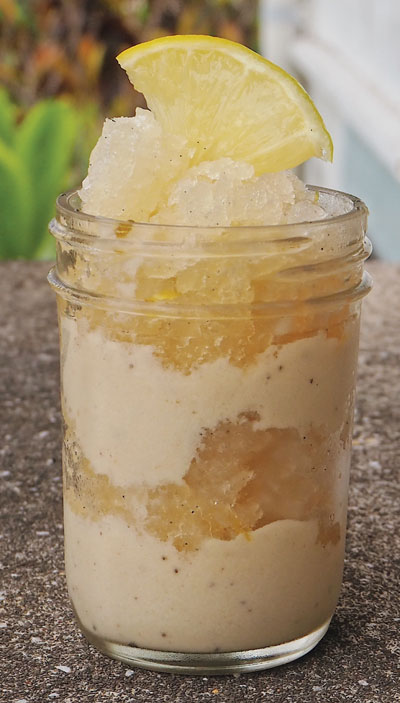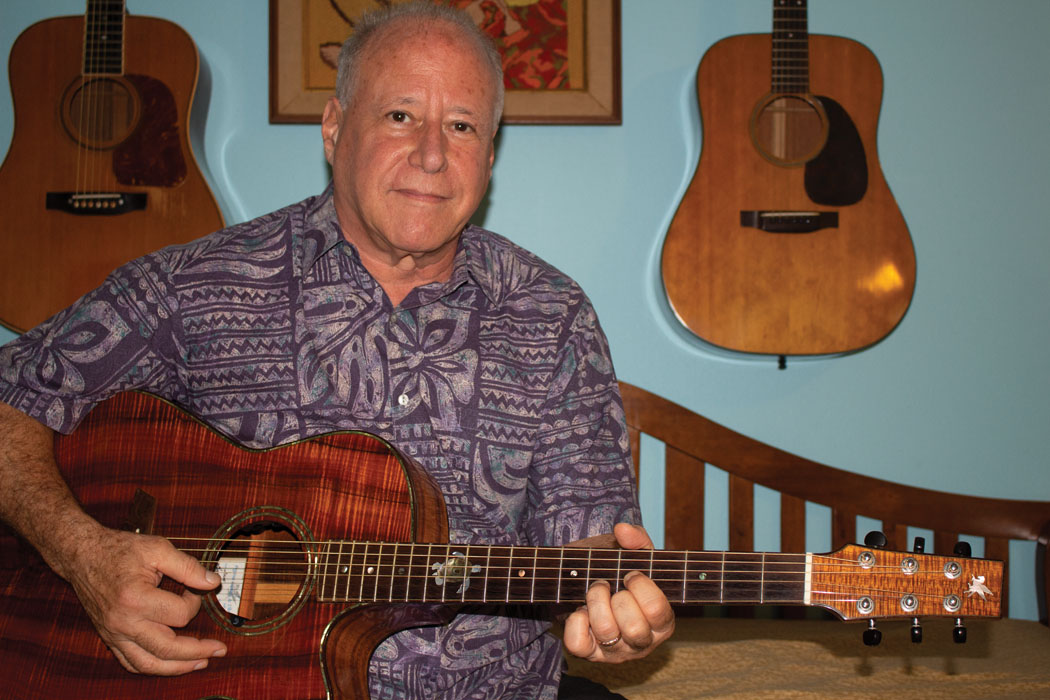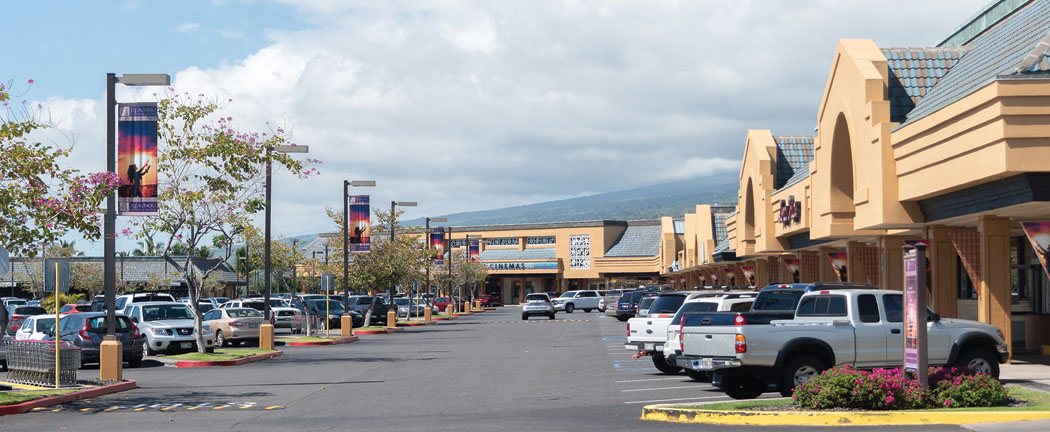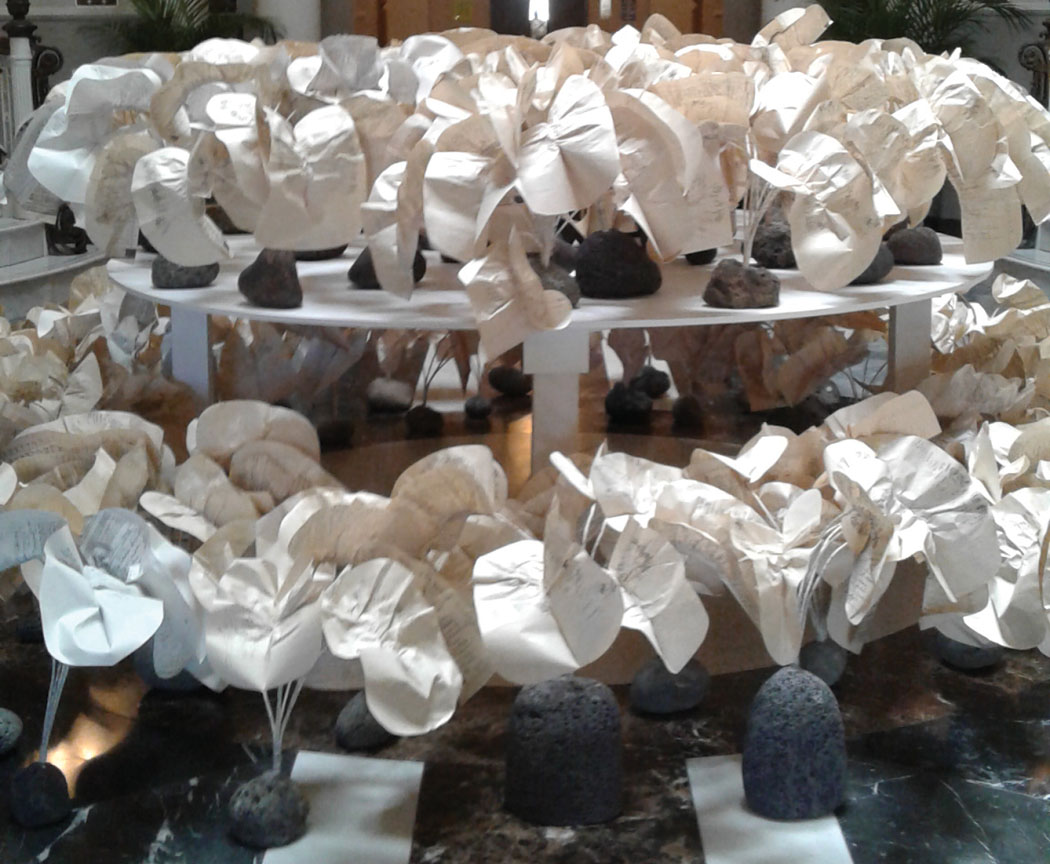
From Kapa to Kalo: Bernice Akamine

By Karen Valentine

As an artist, Bernice Akamine has gone far beyond the basic skills of applying artistic talent to media. When one reaches the pinnacles of art, one has put heart and soul into practice, not to mention, as in Bernice’s case, the expression of cultural heritage retrieved perhaps, as she says, from her Hawaiian ancestors through DNA.
Put simply, she says, “My art is meant to make a statement and preserve cultural knowledge.”
That’s a short yet significant sentence for an artist with several decades of education, multiple media skills, and numerous grants and awards for her work. Her skills began with making plant dyes as a teenager, and perfecting their application on kapa (tapa, cloth made from bark of the mulberry tree) to the point of becoming a consultant to the Smithsonian Institute, bachelor’s and master’s degrees from the University of Hawai‘i at Mānoa in sculpture and glass making, kapa making, hulu (fine feather work and basketry), and multi-media installations in Hawai‘i and across the mainland US.
KALO Installation
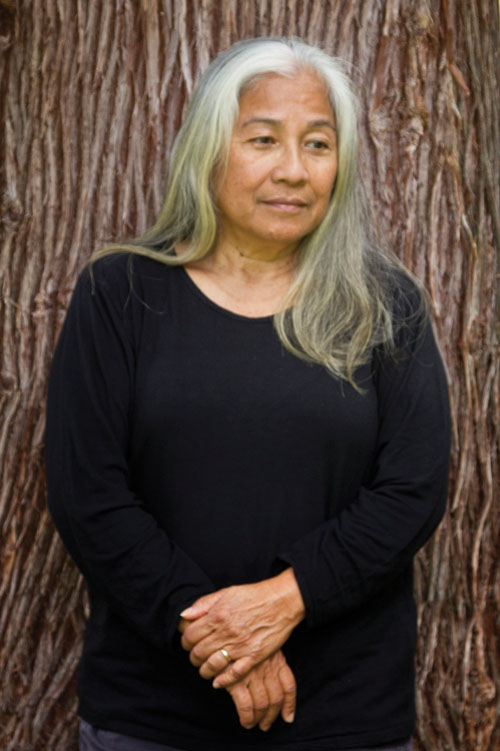
In 2015, Bernice embarked upon a journey to make a historical and cultural statement about the overthrow of the Hawaiian Monarchy, culminating in March 2019, when Bernice mounted an installation exhibit in Honolulu. She was selected as one of 19 artists from Hawai‘i, as well as 28 from Asia and the Americas, to participate in the second Honolulu Biennial Foundation’s exhibit, showing works across the island of O‘ahu from March 8 to May 5, all with the theme “To Make Wrong / Right / Now.”
An art installation refers to a grouping of pieces that often occupy an entire room or gallery space that the spectator has to walk through in order to engage fully with the work. What makes installation art different from sculpture or other traditional art forms is that it is a complete, unified experience that tells a story, rather than a display of separate, individual artworks.
Bernice’s installation is entitled KALO (referring to the kalo or taro plant) and is a grouping of 87 individual kalo plants made of stone and paper. The corm or base of each kalo is represented by a pōhaku (stone) and the leaves are made of newsprint, upon which are printed a copy of signatures from the pages of Kū‘e: The Hui Aloha ‘Aina Anti-Annexation Petitions 1897–1898, divided up by the districts of the five islands from which signatures originated. After the overthrow of Queen Lili‘uokalani by the Provisional Government on January 17, 1893, these petitions were signed in protest.
To understand the significance of using the kalo plant, you must know that the kanaka maoli (native Hawaiians) consider the taro as the elder brother of their race, originating from a legend or mo‘olelo about Papa, the Earth Mother, and Wākea, the Sky Father, birthing first an unformed child. This first child was buried and grew into a taro plant. The second child became the first kanaka maoli.
The pōhaku in the exhibit were donated by community members from the five islands of Kaua‘i, O‘ahu, Maui, Kaho‘olawe, and Hawai‘i to be used for the corm of the kalo plants. The significance of the stones is emphasized by the song Kaulana Na Pua. After the overthrow, members of the Royal Hawaiian Band were told to sign an oath of allegiance to the Provisional Government or they would be out of a job and eating stones. All of the Royal Hawaiian Band members walked out. The band members shared their story with Ellen Prendergast, who wrote the song Mele ‘Ai Pōhaku, The Stone Eater’s Song, or Kaulana Na Pua, as we know the song today.
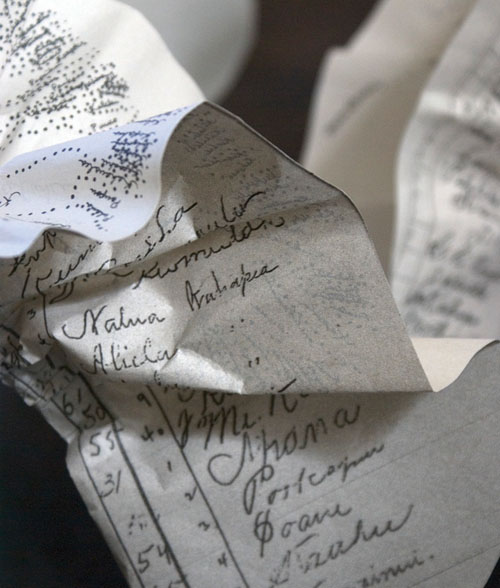
“Everything in that song is significant to why the piece is the way it is. This installation is a non-confrontational way to remind Hawaiians to be proud of their stand for indigenous sovereignty,” says Bernice, “and to stand up and be counted once again, as there is still much to be done and still much that can be lost.”
She continues, “I asked people to donate pōhaku from the different islands where the petitions were signed. The installation is flexible; it can be displayed as one plant or all of them, depending on the space. The Kue: The Hui Aloha ‘Aina Anti-Annexation Petitions were taken to San Francisco by boat and then taken to Washington, DC. So, in June of last year [2018] five of the pieces, one from each island, went to San Francisco and Washington, DC.”
Bernice’s KALO is both an installation and a performance piece, which began at ‘Iolani Palace in Honolulu on March 5, 2019.
During her interview for this story, while preparing for the exhibition, Bernice said, “I am asking for 87 volunteers to go to Honolulu. Each will carry one of these plants and face the balcony where Queen Liliu‘okalani was imprisoned at the palace, and stand behind them. Students from the Hawaiian immersion school Ka Papahana o Mailikukahi Kula on the Wai‘anae coast will do an oli, then I will respond to them. After the protocol is done, we will carry the kalo plants across King Street, following the path of the queen the last time she visited Ali‘iōlani Hale four days before the overthrow of the government. We will then install the kalo plants there in the rotunda, where they will stay until May 5, 2019.”
“Volunteers can be Hawaiian or anyone,” she says. “Not just Hawaiians signed the petitions. However, there is one more thing I ask of the volunteers: That you come with peace in your heart and respect for everyone participating in the installation of KALO, and for the spaces that it occupies.”
A grant from the Native Arts and Cultures Foundation, assistance from Honolulu Biennial Foundation, and Second Sister Foundation supported the exhibit, which won an Honorable Mention award at the event.
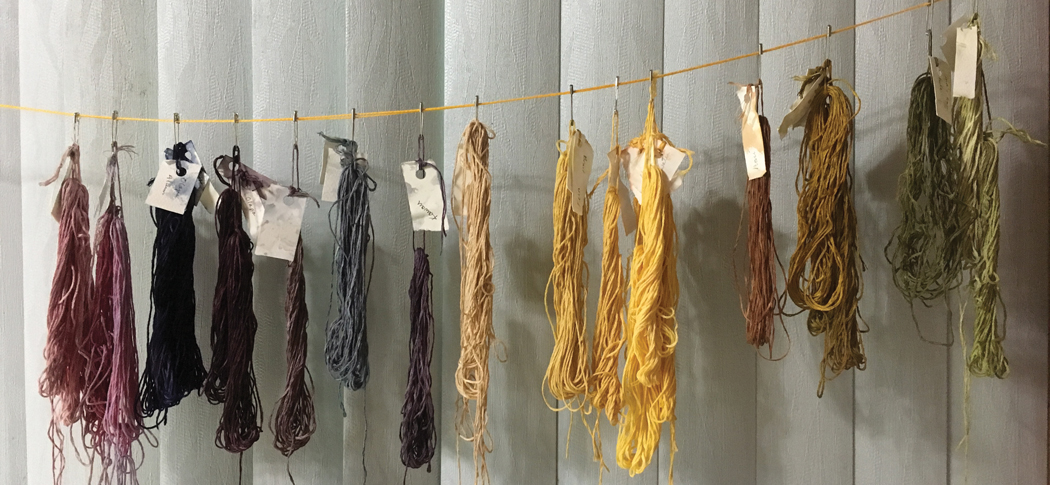
Plant Dyes and Kapa

In 2005, Bernice began documenting the colors resulting from dyes made from native Hawaiian plants during her internship at Amy B. H. Greenwell Ethnobotanical Garden. She created a book of about 20 samples of dye paired with the plant photos.
“I realized that so many of the Hawaiian plants are on the endangered species list. I felt it very important to document this. The books about dyes tell you things but there are no images to show the true shades. I encourage people who make dyes; however, to use non-native plants to protect those that are endangered.”
Bernice also makes kapa because she makes dyes, she says. Her kapa is decorated with her original dyes. One special piece was exhibited recently during the Merrie Monarch Festival at the Wailoa Center in Hilo. Entitled Mo‘olelo, the 23-by-41-inch piece is symbolic of the god Maui and his deeds.
A 2015 documentary film, Ka Hana Kapa, features Bernice and other kapa makers including master kapa maker Marie McDonald. The program culminates with the dressing of a hula hālau, Hālau o Kekuhi, in Hawaiian kapa for the Merrie Monarch Festival.
“It was the first time in over 100 years, a hālau was dressed in original kapa,” Bernice says. They wore the kapa for their performance at the opening of the 2011 Merrie Monarch Festival, which is shown in the film.
“In 2011, after we made kapa for the Merrie Monarch Festival, I was invited to the Smithsonian and made up a dye kit for them to help them identify the plants that made the kapa colors in their collections.”
Bernice is also currently working on a book on kapa with other craftsmen.
Multi-Media: Featherwork and Glass
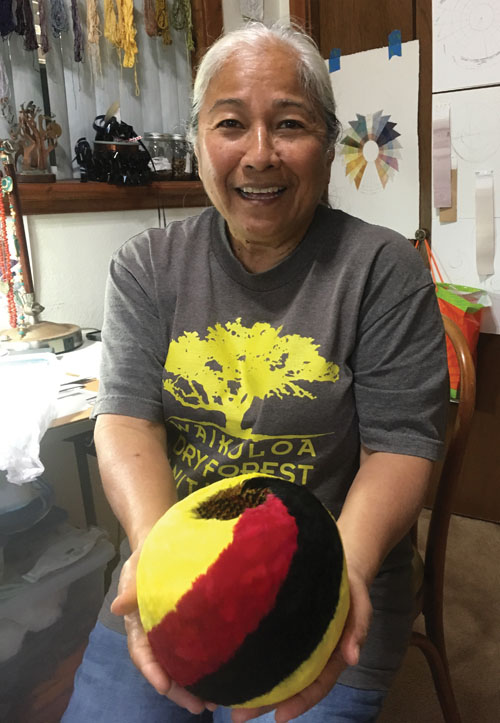
The multi-tasking, multi-media artist is also finishing a commission for the Australian Museum.
“I was asked to do a response piece to Kalaniopu‘u’s feather cape for an exhibit in Australia. A response piece is art that is created after you look at something and make something that is influenced by it.”
The red and yellow ‘ahu ‘ula (feather cape), which was taken by Captain Cook to New Zealand, has recently been returned to Honolulu.
“They are going to be celebrating an anniversary of Cook’s voyages soon, so they were looking for artists to do a response piece or another piece. My response was to represent the Hawaiian Islands, England, and the cape’s final resting place in Australia.” Bernice’s contributions include a basket vessel covered in red and yellow feathers, which she says represents a volcano fissure. Another is covered in black and white, representing lava and sandstone, while the third will represent the ocean.
In response to the 2017 missile incident in Hawai‘i, Bernice made a protest statement, creating sculptures of spent ammunition cases with pieces of earth encased in blown glass.
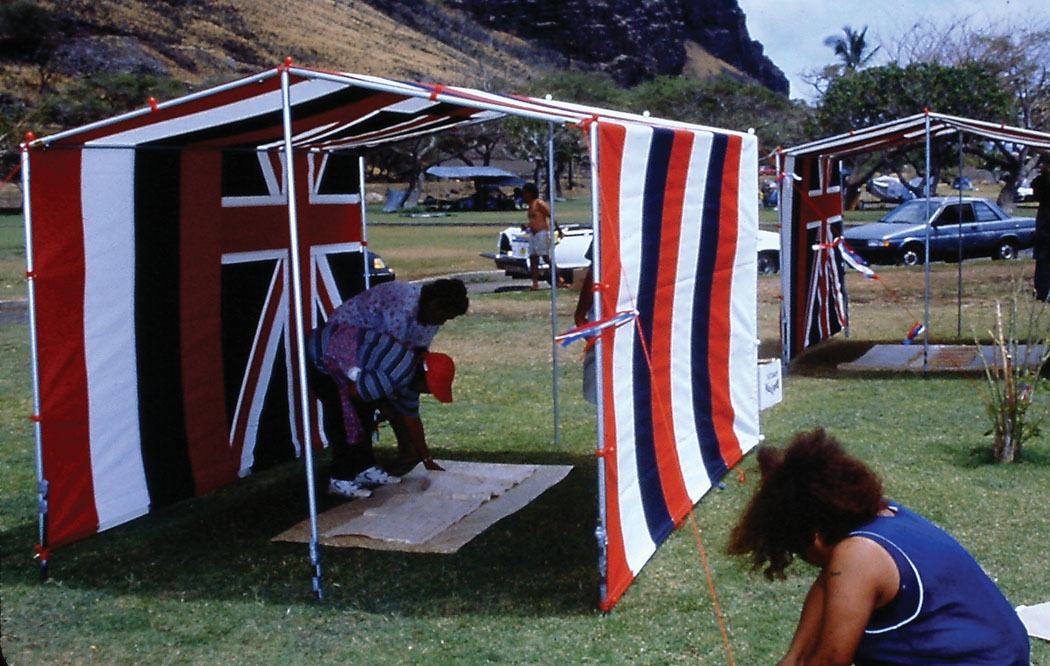
Making a Statement
Bernice has also created a traveling installation, Ku‘u One Hānau, about the Hawaiian houseless, intended to be placed at different sites, saying, “We are not homeless, we are houseless. Hawai‘i is our home.” The installation is made of tents covered with large Hawaiian flags. “I worked with predominantly Hawaiian communities, the houseless communities. We even camped with them. When I installed them on different sites on O‘ahu and here, people camped with them. The first one had images of people eating sandwiches or watering their plants in tin cans because they have to move. Wherever we installed it, we asked people living there to add their handprints to the flag.”
The artist has received many fellowships and awards throughout her career. She lives and works in Volcano with her husband, Glenn, and has many plans for making more statements with her art in the future. ❖
Contact Bernice Akamine: bamakamine@gmail.com
